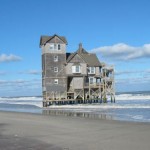By Peter Galuszka
North Carolina’s Outer Banks have always been a touchstone for me – in as much as anyone can associate permanence with sandy islands being perpetually tossed around by tremendous wind and water forces.
The Banks and I go back to 1954 and Hurricane Hazel when I was an infant. They mark many parts of my life. So, I read with great interest The Washington Post story by Lori Montgomery about how real estate officials in Dare County and other coastal parts of North Carolina are trying to alter clear-cut scientific projections about how deeply the islands will be under water by 2100.
State officials say that the ocean should rise 39 inches by the end of the century. This would mean that 8,500 structures worth $1.4 billion would be useless. Naturally, this has upset the real estate industry which is pushing for a new projection of an 8-inch rise 30 years from now. Think of it like a photo in a rental brochure. You don’t choose shots of dark and stormy days. The skies must be blue.
Ditto science. The insanity is that so many still don’t believe what is going on with climate change and carbon dioxide pollution. Over the past several years, Virginians, many of whom vacation on the Outer Banks, endured and paid for former Atty. Gen. Kenneth Cuccinelli’s legal attacks against a former University of Virginia climatologist who linked global warming to human activity. The assaults went nowhere.
Instead of addressing such profoundly transitory events, too many in the region say it isn’t so or pick away at what is really happening as we speak. And as Mother Jones magazine points out, it isn’t because weather change deniers, usually conservatives, don’t understand science.
The Outer Banks are an extreme example because of their incredible fragility. Anyone with even a cursory understanding of the islands knows that they are completely under the thumb because they are where two major ocean currents meet.
The only reason Hatteras has developed at all is the Bonner Bridge, an ill-conceived, 51-year-old span over Oregon Inlet so decrepit that it is often closed for repairs. Replacing it has been constantly delayed by the lack of funding and the threat of lawsuits. The federal government has been complicit for decades by spending at least hundreds of millions on sand replenishment programs or offering flood insurance coverage.
About 15 miles south of the bridge is Rodanthe, a flyspeck village just south of Pea Island National Wildlife Refuse. It is at the point of the Banks that sticks out farthest into the Atlantic and is under the strongest attack by ocean currents and storms. Route 12, the only way to evacuate by car when a hurricane comes, is on a narrow spit of constantly shifting sand trapped between the ocean and Pamlico Sound.
I’ve been going to Rodanthe for years. Starting in the 1980s, friends and I would pool our money and rent one of the big beach houses. We have been constantly amazed how the distance between the structures and the surf is disappearing. One favorite spot was “Serendipity,” a skinny, tall beach house that we rented perhaps twice and featured fantastic views from the top-floor bar.
It was dressed up as a bed and breakfast in the movie ”Nights At Rodanthe,” a 2008 weeper starring Richard Gere and Diane Lane. The film was panned and the house was equally threatened. In fact, the next year, the owner had the whole thing placed on a truck and moved nearly a mile down the coast where there’s a little more sand.
More hurricanes followed, cutting a new inlet a few miles into Pea Island and its watery bird impoundments. The oceanfront houses we used to rent are in trouble. The ones across Route 12 now have dramatic new views. A small, new bridge spans the inlet.
One can argue that building on the Banks is madness, global warming or not. There’s a lot of truth to this. But rising ocean water is truly going to accelerate the changes no matter how hard politicians or North Carolina’s real estate industry say it isn’t so.



